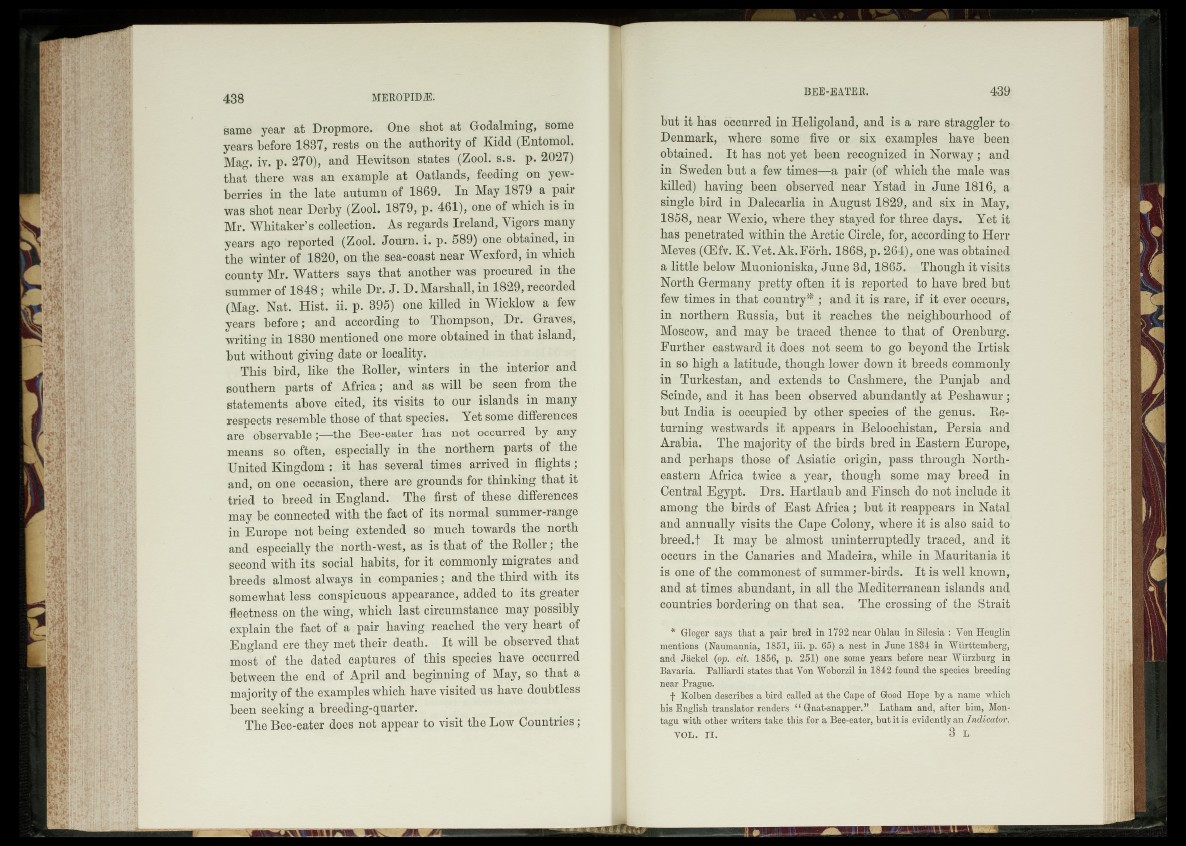
same year at Dropmore. One shot at Godaiming, some
years before 1887, rests on the authority of Kidd (Entomol.
Mag. iv. p. 270), and Hewitson states (Zool. s.s. p. 2027)
that there was an example at Oatlands, feeding on yew-
berries in the late autumn of 1869. In May 1879 a pair
was shot near Derby (Zool. 1879, p. 461), one of which is in
Mr. Whitaker’s collection. As regards Ireland, Vigors many
years ago reported (Zool. Journ. i. p. 689) one obtained, in
the winter of 1820, on the sea-coast near "Woxford, in which
county Mr. Watters says that another was procured in the
summer of 1848 ; while Dr. J. D. Marshall, in 1829, recorded
(Mag. Nat. Hist. ii. p. 395) one killed in Wicklow a few
years before; and according to Thompson, Dr. Graves,
writing in 1830 mentioned one more obtained in that island,
but without giving date or locality.
This bird, like the Roller, winters in the interior and
southern parts of Africa; and as will be seen from the
statements above cited, its visits to our islands in many
respects resemble those of that species. Yet some differences
are observable;—the Bee-eater has not occurred by any
means so often, especially in the northern paits of the
United Kingdom : it has several times arrived in flights;
and, on one occasion, there are grounds for thinking that it
■tried to breed in England. The first of these differences
may be connected with the fact of its normal summer-range
in Europe not being extended so much towards the north
and especially the north-west, as is that of the Roller; the
second with its social habits, for it commonly migrates and
breeds almost always in companies; and the third with its
somewhat less conspicuous appearance, added to its greater
fleetness on the wing, which last circumstance may possibly
explain the fact of a pair having reached the very heart of
England ere they met their death. It will be observed that
most of the dated captures of this species have occurred
between the end of April and beginning of May, so that a
majority of the examples which have visited us have doubtless
been seeking a breeding-quarter.
The Bee-eater does not appear to visit the Low Countries;
but it has occurred in Heligoland, and is a rare straggler to
Denmark, where some five or six examples have been
obtained. It has not yet been recognized in Norway ; and
in Sweden but a few times—a pair (of which the male was
killed) having been observed near Ystad in June 1816, a
single bird in Dalecarlia in August 1829, and six in May,
1858, near Wexio, where they stayed for three days. Yet it
has penetrated within the Arctic Circle, for, according to Herr
Moves (CEfv. K. Vet. Ak.Fdrh. 1868, p. 264), one was obtained
a little below Muonioniska, June 3d, 1865. Though it visits
North Germany pretty often it is reported to have bred but
few times in that country* ; and it is rare, if it ever occurs,
in northern Russia, but it reaches the neighbourhood of
Moscow, and may be traced thence to that of Orenburg.
Further eastward it does not seem to go beyond the Irtisk
in so high a latitude, though lower down it breeds commonly
in Turkestan, and extends to Cashmere, the Punjab and
Scinde, and it has been observed abundantly at Peshawur;
but India is occupied by other species of the genus. Returning
westwards it appears in Beloochistan, Persia and
Arabia. The majority of the birds bred in Eastern Europe,
and perhaps those of Asiatic origin, pass through Northeastern
Africa twice a year, though some may breed in
Central Egypt. Drs. Hartlaub and Finsch do not include it
among the birds of East Africa ; but it reappears in Natal
and annually visits the Cape Colony, where it is also said to
breed.! It may be almost uninterruptedly traced, and it
occurs in the Canaries and Madeira, while in Mauritania it
is one of the commonest of summer-birds. It is well known,
and at times abundant, in all the Mediterranean islands and
countries bordering on that sea. The crossing of the Strait
* Gloger says that a pair bred in 1792 near Ohlan in Silesia : Von Heuglin
mentions (Naumannia, 1851, iii. p. 65) a nest in June 1834 in Wiirttemberg,
and Jacket (op. cit. 1856, p. 251) one some years before near Wiirzburg in
Bavaria. Talliardi states that Von Woborzil in 1842 found the species breeding
near Prague.
f Kolben describes a bird called at the Oape of Good Hope by a name -which
his English translator renders “ Gnat-snapper.” Latham and, after him, Montagu
with other writers take this for a Bee-eater, but it is evidently an Indicator.
VOL. II. 3 L